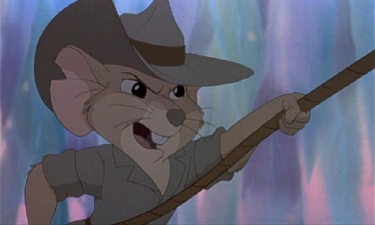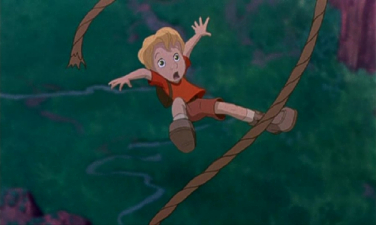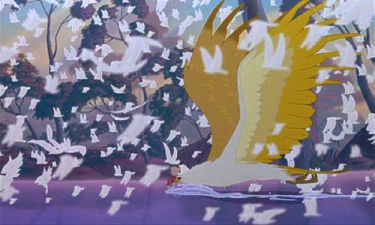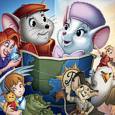Walt Disney Feature Animation (November 16 1990), Walt Disney Home Video (August 1 2000), single disc, 77 mins, 1.66:1 anamorphic widescreen, Dolby Digital 4.0 Surround, Rated G, Retail: $19.99
Storyboard:
This sequel to Disney’s 1977 animated hit The Rescuers follows the adventures of Cody, a young boy in the Australian Outback, and begins with his daring rescue of a great golden eagle, Marahute. Falling from the precarious ledge where Marahute is trapped, the eagle swoops him up in the nick of time and the two bond during an amazing flight sequence, expertly handled by the terrific Disney animator Glen Keane. Although both are safe for the time being, Cody is soon in peril again, this time from illegal poacher Percival McLeach, who finds the young boy snared in one of his traps. Cody threatens to contact the authorities, but McLeach is too quick and shuts him up in one of his cages. This leaves a little mouse – the only one to have seen the proceedings – to contact RAS, the Rescue Aid Society that helped the orphan Penny in the first film. Bernard has been promoted to top agent, and obviously still burns a candle for Miss Bianca. We first see them at dinner, with a nervous Bernard trying to pluck up the courage to pop the big M question to Bianca. Unfortunately, before he’s had time to show her the ring, they are whisked off to save Cody: first stop Albatross Air! Jim Jordan, who played Orville back in 1977 had passed away, so John Candy steps in as…who else…Orville’s brother Wilbur! As terrified as ever of unstable air travel, Bernard buckles in for another flight, and a stand out CG-enhanced sequence that takes them from the New York City skyline to the wild Outback of Australia. Here, they team up with Jake, a “kangaroo-mouse Dundee” to help save Cody and Marahute, who has fallen under the greedy sights of McLeach…

The Sweatbox Review:
I never worked one thing out about The Rescuers Down Under (still one of only two “official” Disney sequels, with Fantasia/2000, to be generated by the Feature Animation studio and released theatrically) – namely, why the heck didn’t they make more? The first Rescuers movie, released in 1977, could arguably be seen as the last in the original line up of Disney films that began with Snow White 40 years earlier. All subsequent films from the Studio were introducing the new generation of artists that would prove their talents, with films like Pete’s Dragon (1977), The Fox And The Hound (1981) and Mickey’s Christmas Carol (1983).
The eventual “shake up” of The Black Cauldron (1985) set the Studio on a new course to try and return to the traditional values of Disney’s past, and the very reason many of the artists had joined the Studio in the first place. The “animation renaissance” of the late 80s through the mid 90s was very much due to these creative people, before they somewhat became slaves to their own success. Nowadays, each animated feature (from any studio) must “top” the last one, meaning costs go up while the films become more “safe”. Disney’s way of combating this was the introduction of the video sequel; films that had low start up costs and could bring in quick revenue while providing a continuation of the Studio’s classic stories and characters. Which leads me back to my original question: even with this business model in mind, why hasn’t the Studio tapped on the characters in the Rescuers movies to create more?
Out of all the films in Disney’s library, perhaps none was more suitable for the follow up treatment than The Rescuers. It was a contemporary story, based on a series of books (by Margery Sharp) and the leads, Bernard and Miss Bianca, naturally lent themselves to continuing adventures. It was, by the way, also my favorite Disney film for many years, probably as it was the first one I was old enough to see in the theater. When the sequel was announced, I just couldn’t wait! Originally pitched as a low-budget movie, the Disney Studio was trying to keep costs down after the huge outlays for such big films as Who Framed Roger Rabbit and The Little Mermaid. A sequel project was suggested, as it meant that characters would have already been created, concepts already developed and an audience already established. Perhaps for reasons I have outlined above, The Rescuers was chosen, also probably because it remained the Studio’s most successful film on original release. What began as an idea for a fairly inexpensive movie actually turned out far more costly, but was artistically successful, due mainly to the new CG technology which allowed animators to move around their subjects; a technique that had been discovered and explored in Who Framed Roger Rabbit and would find its apex in the ballroom sequence of Beauty And The Beast.

The Rescuers Down Under was the first Disney animation film of recent times to be entirely post-produced within the computer and scanned back out to film for theatrical exhibition. This opened up the possibilities of the animation medium expansively, allowing for greater colors, depth and involvement for the audience. The film was sold on posters as “the first animated action-adventure movie”, and although of course this isn’t strictly true, the publicists were getting at the fact that this was a much more “edgier” approach, with no songs, but plenty of scrapes and near-misses – think of a tooned-up Jerry Bruckheimer film!
In a featurette made during the making of the film back in 1990, Glen Keane described the movie as “probably the most technically advanced feature we’ve ever done” and it still holds up today. Some of the computer-generated animation is simply amazing, and seeing it again on a big screen with crystal clarity is breathtaking. In general, the character animation is appealing and these are still written as the same characters we loved in the original The Rescuers. Bob Newhart and Eva Gabor (who also provided Duchess’ voice in The AristoCats) return to Bernard and Bianca for their trip Down Under, and it’s interesting to compare the animation styles between both pictures.

The Rescuers was one of the last features produced in the Xerox “pencil line” way, with Down Under the first product of the computer ink and paint system. In the other voices, Candy gives it all he’s got and is his usual loud but loveable self in the Wilbur role, often providing the funniest lines (including an at-the-time very topical “Cowabunga!”) and finding himself the butt of a couple of situations. Although he’s a secondary character, Candy makes sure you don’t forget him, and his talent is still sorely missed today.

This really is a very underrated film. All the characters have a great deal of depth to them, and in McLeach we get a very “real-life” villain. Voiced by veteran actor George C. Scott, McLeach operates on with a one-track motive, but Scott brings him a cool and calculating menace boiling beneath the surface, letting slip that he really could actually turn out to be very nasty indeed. Adam Ryen’s Cody is only slightly less successful, mainly due to his Americanized Australian accent. I was quite surprised to find that he was actually of Scandinavian descent and had only been in America five years previous to recording his lines for Down Under. As a character, Cody works just right. He’s not just a replacement for Penny from the original film; he gets stuck in and tries to make things happen. We can believe his friendship with Marahute due to the “acting” from both characters.

As for the leads, there is a nice gentle interplay between Bernard and Bianca that can only come from experienced players like Newhart and Gabor, both bringing a sense of backstory with them in the voices that doesn’t even need describing in the script. What is nice is that you don’t have to have seen the original film to keep up with the in-jokes and familiar scenes and characters. Disney was mindful that a generation had passed between the two films and were careful not to let too much rest on the earlier film. In the end, they needn’t have worried – many of the kids who saw the 1977 movie were now parents themselves and more than enjoyed taking their kids along to see the new adventure!
Released soon after the Disney Studio’s own DuckTales adventure movie spin-off, the film was not as successful as some would have hoped, even with the latest Mickey Mouse comeback featurette, The Prince And The Pauper, presented on the double-bill. Even though the film has since enjoyed a following on video, perhaps its standing as a supposed commercial failure is why the Studio will not commit to the further adventures of Bernard and Miss Bianca. But, as we have seen recently with other artistic triumphs, such as Balto (1995), The Iron Giant (1999) and Titan AE (2000), sometimes the box-office audience gets it wrong. The Rescuers Down Under is most certainly in that class; its straightforward storytelling and groundbreaking technique make it a complete delight!
Is This Thing Loaded?
The only real extra relating directly to the main feature is its original theatrical trailer. Originally, The Rescuers Down Under was coupled with Mickey Mouse’s return to the screen in The Prince And The Pauper, and the trailer emphasized this. Interestingly, this version merely cuts off (though it’s well done) just before the extended Mickey ad would have begun. As usual, having the trailer is a nice inclusion and something missing more and more on recent Disney discs.
The rest of the features are strictly for the kids. A trivia game does not come with any bells and whistles, being simply a 16-page question and answer pastime, featuring questions based on the film. The DVD storybook replays the story, with the choice of reading it yourself or having the story read aloud with music and sound effects from the film, packing the entire story in just over 12 minutes, though it could take potentially much more than that to get through the read-along version with a small child!
This being a fairly early Gold Collection release, the promotional trailers begin thick and fast the moment the disc starts up. On this title, we get previews for the Gold Collection itself, Buzz Lightyear, The Tigger Movie, Little Mermaid II, and Toy Story 2. And where are Bernard and Miss Bianca when you really need them? When it comes to DVD-ROM supplements, it’s those that need rescuing – there are none here!
Case Study:
As well as the white keepcase and fairly inviting cover art, we get a chapter index card with a gorgeous concept painting of Cody and Marahute in full flight, while the reverse makes mention of the game and storybook. Best of all is the enclosed 12-page Animals Of The Outback booklet which offers some facts, figures and fun on the real animals of Australia and compares them to their animated counterparts.
Ink And Paint:
Although the first animated film to benefit from computer post-production, this transfer comes from a film print and not directly from digital. The print, even though it has a fair few scratches, is in overall good shape, and I think the slight grain actually gives it a more “cinematic look”. From the opening low-angle swoosh through the Outback, through the rooftop launch in New York, to the high-flying ending, there’s nothing objectionably wrong with how this film looks. The Rescuers Down Under marked a huge improvement in animation technique, introducing the digital ink and paint systems that retain the animator’s hand drawn line more precisely, and providing a wider range of color choices. The look of Down Under is “hot”; you can practically feel that burn coming off the screen, and its original anamorphically enhanced 1.66:1 ratio (which actually looks like another 1.78:1 compromise) creates an epic feel.

Scratch Tracks:
Presented in Dolby 4.0 Surround, the audio features enough atmosphere in the surrounds to keep it interesting. Bruce Broughton’s fantastically involving score, until recently a long out of print CD and a hot item on auction sites, absolutely pulsates through the air. The main title excites greatly and perfectly sets up the fact that this one is going to be a little different, while the pivotal eagle flight near the beginning of the film is a tour de force of all the elements: music, animation, effects, pacing and direction; one of the most all-round accomplished scenes in all of Disney, magnificently on display here. Also included are more than competent dubbed tracks for French and Spanish listeners, both in Dolby 2.0 Surround, and English subtitles.
Final Cut:
The Rescuers Down Under is a fine addition to the Disney library, and most certainly the best sequel produced so far. It’s the Studio heading toward the top of their game, with all the tools at their disposal, pushing boundaries while still paying attention to details and story. Even greater heights would be reached with Beauty And The Beast, Aladdin and The Lion King, and their animation art would continue to be refined, but it’s in The Rescuers Down Under that all those techniques were first put to the test, and on the most part it’s very successful in every way. Now, with this disc edition, lets hope enough units sell to warrant another episode, and even if it is direct to video, we’ll still have those wonderful characters to enjoy the ride with!
 | ||
 |









